The amphibian excavator market is projected to expand from USD 467.3 million to USD 685.1 million, generating an absolute increase of USD 217.8 million during the period ending 2035. This translates into a compound annual growth rate of 3.9% and represents a growth multiplier of 1.46x compared with the baseline period beginning in 2025. To understand this trajectory, it is important to assess how the industry has developed historically, how it stands in the present, and what shifts are expected in the forecast horizon ending 2035.
Historically, the category was relatively niche, concentrated in wetland restoration, dredging, and riverbank stabilization projects before 2025. Market size remained below USD 450 million in the years preceding 2025, with adoption largely dependent on public infrastructure funding cycles and environmental restoration initiatives. Established players in Europe and parts of Asia dominated demand due to specialized engineering capabilities, while regional fragmentation limited penetration into developing regions. Usage was primarily focused on state-backed initiatives, making historical growth steady but constrained by funding availability in the years prior to 2025.
At present, the industry value is set at USD 467.3 million during the baseline year of 2025. Growth at this stage is supported by broader adoption across commercial contractors and by the gradual entry of smaller manufacturers providing compact, cost-efficient models. Market share remains concentrated among established players with long-term dredging and restoration contracts, but share shifts are already visible as smaller firms gain traction in flood-prone regions of Southeast Asia and Africa. Between 2025 and 2030, the amphibian excavator market is expected to climb to USD 553.2 million, representing an increase of USD 85.9 million and accounting for 39% of the decade’s overall growth. This segment reflects a CAGR of 3.4% across the first half of the cycle ending 2030.
The forecast trajectory highlights stronger value addition during the latter half, with the amphibian excavator market expanding from USD 553.2 million to USD 685.1 million and delivering USD 131.9 million in incremental growth between 2030 and 2035. This contribution equals 61% of the total expansion, showing that innovation and broader adoption drive higher value creation in the latter part of the cycle ending 2035. The CAGR for this phase is calculated at 4.3%, indicating a marginal acceleration compared with the earlier stage. Growth is expected to be driven by lightweight materials, enhanced mobility, fuel-efficient engines, and the integration of telematics, which will differentiate leading brands from lagging manufacturers.
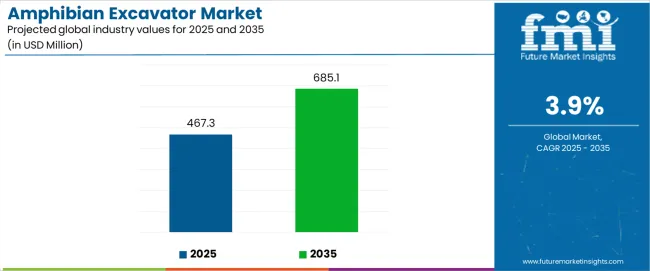
| Period | Primary Revenue Buckets | Share | Notes |
|---|---|---|---|
| Today | Shallow water excavators (0-3m depth) | 62% | Traditional applications, established contractors |
| Deep water excavators (3m+ depth) | 28% | Specialized marine operations | |
| Emergency rescue equipment | 10% | Disaster response, flood management | |
| Future (3-5 yrs) | Advanced shallow water systems | 52-55% | Enhanced maneuverability, GPS integration |
| Deep water specialized units | 22-25% | Extended reach, advanced hydraulics | |
| Dredging applications | 8-12% | Port maintenance, channel clearing | |
| Construction engineering | 6-10% | Bridge construction, underwater infrastructure | |
| Emergency rescue operations | 5-8% | Flood response, disaster management | |
| Environmental remediation | 4-7% | Wetland restoration, habitat management |
At-a-Glance Metrics
| Metric | Value |
|---|---|
| Market Value (2025) | USD 467.3 million |
| Market Forecast (2035) | USD 685.1 million |
| Growth Rate | 3.9% CAGR |
| Leading Operation Type | Shallow Water Operations |
| Primary Application | Dredging & Construction Segment |
The amphibian excavator market demonstrates strong fundamentals with shallow water operation systems capturing a dominant share through advanced hydraulic properties and marine application optimization. Dredging and construction applications drive primary demand, supported by increasing coastal development requirements and marine infrastructure modernization initiatives. Geographic expansion remains concentrated in developed markets with established marine construction infrastructure, while emerging economies show accelerating adoption rates driven by coastal development initiatives and rising environmental management standards.
Primary Classification: The amphibian excavator market segments by operation type into shallow water, deep water, and specialized operations, representing the evolution from basic amphibious capabilities to sophisticated multi-depth excavation systems for comprehensive marine construction optimization.
Secondary Classification: Application segmentation divides the amphibian excavator market into dredging, construction engineering, emergency rescue, and others, reflecting distinct requirements for excavation performance, operational depth capabilities, and environmental compliance specifications.
Tertiary Classification: End-use segmentation covers marine contractors, dredging companies, construction firms, government agencies, and environmental organizations, while distribution channels span direct sales, equipment dealers, and specialized marine equipment suppliers.
Regional Classification: Geographic distribution covers North America, Latin America, Western Europe, Eastern Europe, East Asia, South Asia Pacific, and Middle East & Africa, with developed markets leading adoption while emerging economies show accelerating growth patterns driven by coastal development programs.
The segmentation structure reveals operational progression from traditional shallow water excavators toward sophisticated deep water systems with enhanced environmental compliance capabilities, while application diversity spans from port dredging to specialized underwater construction requiring precision excavation solutions.
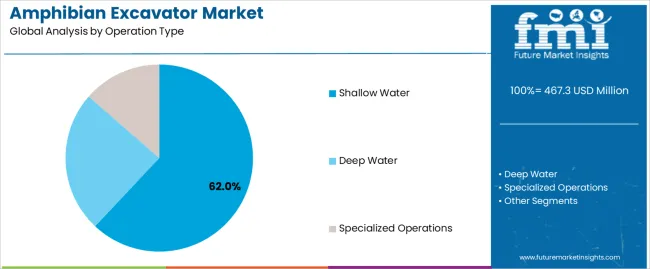
Market Position: Shallow water operation systems command the leading position in the amphibian excavator market with 62% market share through proven hydraulic technologies, including buoyancy optimization, maneuverability enhancement, and depth control capabilities that enable marine contractors to achieve optimal excavation performance across diverse coastal and wetland environments.
Value Drivers: The segment benefits from marine industry preference for versatile excavation systems that provide operational flexibility, environmental compliance, and cost-effective deployment without requiring deep water infrastructure. Advanced shallow water processing features enable enhanced sediment handling, precise depth control, and integration with existing marine equipment, where operational efficiency and environmental protection represent critical project requirements.
Competitive Advantages: Shallow water excavation systems differentiate through proven operational reliability, versatile deployment characteristics, and integration with established marine construction workflows that enhance project effectiveness while maintaining optimal environmental compliance suitable for diverse aquatic applications.
Key market characteristics:
Deep water operation systems maintain a 28% market position in the amphibian excavator market due to their specialized capabilities and advanced hydraulic positioning benefits. These systems appeal to contractors requiring sophisticated excavation solutions with enhanced depth profiles for large-scale marine projects. Market growth is driven by port development expansion, emphasizing specialized equipment solutions and operational efficiency through optimized depth designs.
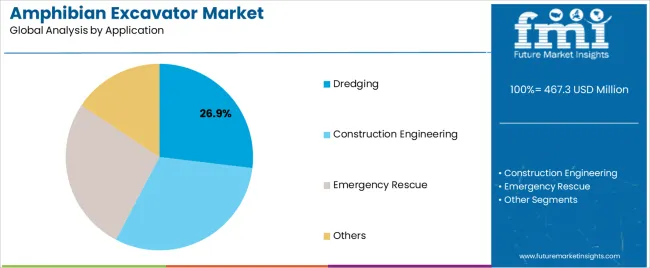
Market Context: Dredging applications demonstrate strong growth in the amphibian excavator market with 5.8% CAGR and 26.9% market share due to widespread adoption of specialized excavation systems and increasing focus on port maintenance, navigational channel improvement, and sediment management applications that maximize excavation effectiveness while maintaining environmental standards.
Appeal Factors: Dredging operators prioritize equipment reliability, sediment handling efficiency, and integration with existing marine infrastructure that enables coordinated excavation operations across multiple project phases. The segment benefits from substantial port development investment and modernization programs that emphasize the acquisition of specialized excavators for channel maintenance and harbor expansion applications.
Growth Drivers: Port expansion programs incorporate amphibian excavators as essential components for sediment management, while coastal development growth increases demand for excavation capabilities that comply with environmental regulations and minimize operational complexity.
Market Challenges: Varying environmental regulations and operational depth complexity may limit equipment standardization across different marine projects or coastal scenarios.
Application dynamics include:
Construction engineering applications capture 24% market share through specialized infrastructure requirements in bridge construction, underwater foundations, and marine facility development. These projects demand precision excavators capable of supporting structural requirements while providing accurate positioning access and operational stability capabilities.
Emergency rescue applications account for 18% market share, including flood response, disaster management, and emergency infrastructure repair requiring rapid deployment excavation capabilities for safety optimization and operational effectiveness.
Market Context: Marine Contractors dominate the amphibian excavator market with a 4.5% CAGR, reflecting the primary demand source for amphibious excavator technology in coastal construction applications and marine infrastructure development.
Business Model Advantages: Marine Contractors provide direct market demand for specialized excavation systems, driving equipment innovation and operational optimization while maintaining project quality and environmental compliance requirements.
Operational Benefits: Marine Contractor applications include project specialization, cost efficiency, and regulatory compliance that drive consistent demand for excavation systems while providing access to the latest hydraulic technologies.
| Category | Factor | Impact | Why It Matters |
|---|---|---|---|
| Driver | Coastal development & marine infrastructure growth (port expansion, waterway maintenance) | ★★★★★ | Growing marine construction market requires specialized excavators with enhanced depth capabilities and environmental compliance properties proven effective across coastal applications. |
| Driver | Environmental regulations advancement & compliance requirements (sediment management, habitat protection) | ★★★★★ | Transforms equipment requirements from "basic excavation" to "environmental compliance"; operators that offer precision excavators and monitoring features gain competitive advantage. |
| Driver | Port modernization & dredging demand (navigation channels, harbor expansion) | ★★★★☆ | Modern ports need efficient, precise excavation systems; demand for specialized and superior excavation solutions expanding addressable market. |
| Restraint | High equipment costs & capital constraints (especially for smaller contractors) | ★★★★☆ | Smaller marine operators defer equipment upgrades; increases price sensitivity and slows advanced excavator adoption in cost-conscious markets. |
| Restraint | Alternative construction methods competition (land-based alternatives, traditional dredging) | ★★★☆☆ | Conventional construction methods offer established workflows and lower costs, potentially limiting amphibian excavator adoption in traditional applications. |
| Trend | Hydraulic technology integration & performance enhancement (GPS positioning, depth monitoring) | ★★★★★ | Advanced hydraulic properties, precision optimization, and performance analytics transform operations; technology integration and performance enhancement become core value propositions. |
| Trend | Automation & remote operation solutions (unmanned systems, digital controls) | ★★★★☆ | Automated excavators for specialized marine applications; remote operation capabilities and targeted automation features drive competition toward technology solutions. |
The amphibian excavator market demonstrates varied regional dynamics with Growth Leaders including China (5.3% growth rate) and India (4.9% growth rate) driving expansion through coastal development initiatives and marine infrastructure modernization. Steady Performers encompass Germany (4.5% growth rate), Brazil (4.1% growth rate), and developed regions, benefiting from established marine industries and specialized equipment adoption. Mature Markets feature United States (3.7% growth rate), United Kingdom (3.3% growth rate), and Japan (2.9% growth rate), where marine advancement and port modernization requirements support consistent growth patterns.
Regional synthesis reveals East Asian markets leading adoption through coastal expansion and marine infrastructure development, while North American countries maintain steady expansion supported by equipment technology advancement and environmental compliance requirements. European markets show strong growth driven by port applications and precision integration trends.
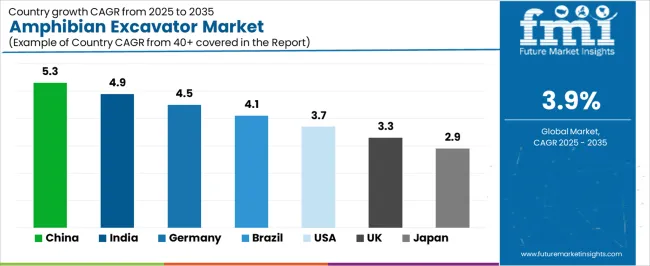
| Region/Country | 2025 to 2035 Growth | How to win | What to watch out |
|---|---|---|---|
| China | 5.3 | Focus on high-volume production solutions | Environmental regulations; local competition |
| India | 4.9 | Lead with cost-effective manufacturing | Import restrictions; technical barriers |
| Germany | 4.5 | Provide precision engineering systems | Over-regulation; lengthy approvals |
| Brazil | 4.1 | Offer value-oriented solutions | Currency fluctuations; import duties |
| United States | 3.7 | Push technology integration | Compliance costs; scaling challenges |
| United Kingdom | 3.3 | Focus on advanced applications | Economic impacts; equipment costs |
| Japan | 2.9 | Emphasize precision manufacturing | Traditional preferences; adoption rates |
China establishes fastest market growth through aggressive coastal development programs and comprehensive marine infrastructure expansion, integrating advanced amphibian excavator systems as standard components in port facilities and waterway construction projects. The country's 5.3% growth rate reflects government initiatives promoting marine infrastructure and domestic equipment capabilities that mandate the use of specialized excavation systems in port and coastal facilities. Growth concentrates in major coastal hubs, including Shanghai, Shenzhen, and Tianjin, where marine development showcases integrated excavation systems that appeal to contractors seeking operational optimization capabilities and coastal applications.
Chinese manufacturers are developing cost-effective excavation solutions that combine domestic production advantages with advanced hydraulic features, including enhanced depth control and improved maneuverability capabilities. Distribution channels through marine equipment suppliers and construction dealers expand market access, while government support for coastal development supports adoption across diverse port and marine segments.
Strategic Market Indicators:
In Mumbai, Chennai, and Kolkata, port facilities and marine contractors are implementing specialized amphibian excavator systems as standard equipment for coastal construction and dredging optimization applications, driven by increasing government marine investment and coastal modernization programs that emphasize the importance of advanced excavation capabilities. The amphibian excavator market holds a 4.9% growth rate, supported by government coastal initiatives and port development programs that promote specialized excavation systems for marine and waterway facilities. Indian operators are adopting excavation systems that provide consistent operational performance and environmental compliance features, particularly appealing in coastal regions where sediment management and operational excellence represent critical project requirements.
Market expansion benefits from growing marine capabilities and international port partnerships that enable domestic production of specialized excavation systems for coastal and marine applications. Technology adoption follows patterns established in construction equipment, where reliability and performance drive procurement decisions and operational deployment.
Market Intelligence Brief:
Germany's advanced marine market demonstrates sophisticated amphibian excavator deployment with documented operational effectiveness in port applications and coastal facilities through integration with existing marine systems and environmental infrastructure. The country leverages engineering expertise in hydraulics and precision systems integration to maintain a 4.5% growth rate. Marine centers, including Hamburg, Bremen, and Lower Saxony, showcase premium installations where excavation systems integrate with comprehensive port platforms and facility management systems to optimize operational performance and environmental effectiveness.
German manufacturers prioritize system precision and EU compliance in excavation development, creating demand for advanced systems with specialized features, including facility integration and environmental monitoring systems. The amphibian excavator market benefits from established marine infrastructure and a willingness to invest in precision excavation technologies that provide long-term operational benefits and compliance with international environmental standards.
Market Intelligence Brief:
Brazil's market expansion benefits from diverse coastal demand, including port modernization in Santos and Rio de Janeiro, marine facility upgrades, and government coastal programs that increasingly incorporate specialized excavation solutions for marine applications. The country maintains a 4.1% growth rate, driven by rising port activity and increasing recognition of amphibian excavator benefits, including precise sediment control and enhanced operational effectiveness.
Market dynamics focus on cost-effective excavation solutions that balance operational performance with affordability considerations important to Brazilian marine operators. Growing port industrialization creates continued demand for modern excavation systems in new marine infrastructure and facility modernization projects.
Strategic Market Considerations:
United States establishes market leadership through comprehensive marine programs and advanced coastal infrastructure development, integrating amphibian excavator systems across port and marine construction applications. The country's 3.7% growth rate reflects established marine industry relationships and mature excavation technology adoption that supports widespread use of specialized excavation systems in port and coastal facilities. Growth concentrates in major marine centers, including California, Louisiana, and Florida, where excavation technology showcases mature deployment that appeals to marine operators seeking proven operational capabilities and environmental compliance applications.
American marine providers leverage established distribution networks and comprehensive technical support capabilities, including training programs and maintenance support that create customer relationships and operational advantages. The amphibian excavator market benefits from mature regulatory standards and environmental requirements that mandate excavation system use while supporting technology advancement and operational optimization.
Market Intelligence Brief:
United Kingdom's marine market demonstrates integrated amphibian excavator deployment with documented operational effectiveness in port applications and coastal facilities through integration with existing marine systems and environmental infrastructure. The country maintains a 3.3% growth rate, supported by marine excellence programs and environmental effectiveness requirements that promote specialized excavation systems for marine applications. Port facilities across England, Scotland, and Wales showcase systematic installations where excavation systems integrate with comprehensive marine platforms to optimize operational performance and environmental outcomes.
UK marine providers prioritize system reliability and industry compatibility in excavation procurement, creating demand for validated systems with proven operational features, including environmental monitoring integration and precision positioning systems. The amphibian excavator market benefits from established marine infrastructure and environmental requirements that support excavation technology adoption and operational effectiveness.
Market Intelligence Brief:
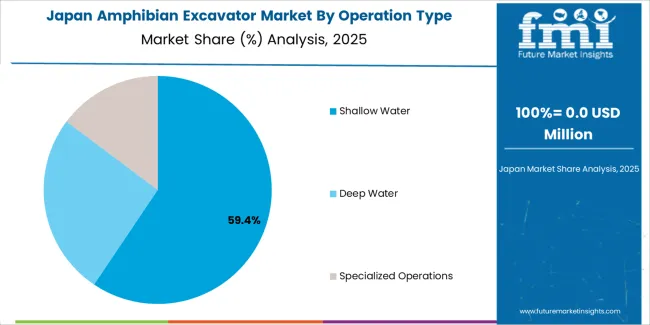
Japan's market growth benefits from precision marine demand, including advanced port facilities in Tokyo and Osaka, technology integration, and efficiency enhancement programs that increasingly incorporate excavation solutions for operational applications. The country maintains a 2.9% growth rate, driven by marine technology advancement and increasing recognition of precision excavation benefits, including accurate depth control and enhanced operational outcomes.
Market dynamics focus on high-precision excavation solutions that meet Japanese quality standards and operational effectiveness requirements important to marine operators. Advanced marine technology adoption creates continued demand for sophisticated excavation systems in port facility infrastructure and marine modernization projects.
Strategic Market Considerations:
The European amphibian excavator market is projected to grow from USD 103.8 million in 2025 to USD 152.4 million by 2035, registering a CAGR of 3.9% over the forecast period. Germany is expected to maintain its leadership position with a 41.2% market share in 2025, supported by its advanced marine infrastructure and major port centers.
United Kingdom follows with a 26.8% share in 2025, driven by comprehensive marine programs and coastal development initiatives. Netherlands holds a 15.4% share through specialized dredging applications and port compliance requirements. Norway commands a 8.7% share, while Denmark accounts for 4.9% in 2025. The rest of Europe region is anticipated to gain momentum, expanding its collective share from 3.0% to 3.8% by 2035, attributed to increasing marine adoption in Mediterranean countries and emerging coastal facilities implementing marine modernization programs.
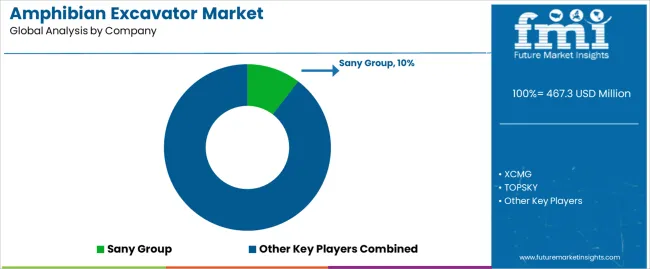
| Stakeholder | What they actually control | Typical strengths | Typical blind spots |
|---|---|---|---|
| Global brands | Distribution reach, broad product catalogs, brand recognition | Wide availability, proven reliability, multi-region support | Product refresh cycles; customer dependency on brand validation |
| Technology innovators | Hydraulic R&D; advanced control technologies; enhanced performance properties | Latest technologies first; attractive ROI on operational effectiveness | Service density outside core regions; scaling complexity |
| Regional specialists | Local compliance, fast delivery, nearby customer support | "Close to customer" support; pragmatic pricing; local regulations | Technology gaps; talent retention in customer service |
| Full-service providers | Equipment programs, training services, maintenance management | Lowest operational risk; comprehensive support | Service costs if overpromised; technology obsolescence |
| Niche specialists | Specialized applications, custom excavators, marine services | Win premium applications; flexible configurations | Scalability limitations; narrow market focus |
| Item | Value |
|---|---|
| Quantitative Units | USD 467.3 million |
| Operation Type | Shallow Water, Deep Water, Specialized Operations |
| Application | Dredging, Construction Engineering, Emergency Rescue, Others |
| End Use | Marine Contractors, Dredging Companies, Construction Firms, Government Agencies, Environmental Organizations |
| Regions Covered | North America, Latin America, Western Europe, Eastern Europe, East Asia, South Asia Pacific, Middle East & Africa |
| Countries Covered | China, India, Germany, Brazil, United States, United Kingdom, Japan, Canada, France, Australia, and 25+ additional countries |
| Key Companies Profiled | Sany Group, XCMG, TOPSKY, REMU, HITACHI, Relong Wetland Equipment, Wilco Manufacturing, Eddy Pump Land & Water, AtlanTrax |
| Additional Attributes | Dollar sales by operation type and application categories, regional adoption trends across East Asia, North America, and Western Europe, competitive landscape with equipment manufacturers and marine suppliers, marine contractor preferences for excavation effectiveness and operational performance, integration with marine platforms and fleet management systems, innovations in hydraulic technology and excavation enhancement, and development of advanced excavation solutions with enhanced performance and environmental optimization capabilities. |
The global amphibian excavator market is estimated to be valued at USD 467.3 million in 2025.
The market size for the amphibian excavator market is projected to reach USD 685.1 million by 2035.
The amphibian excavator market is expected to grow at a 3.9% CAGR between 2025 and 2035.
The key product types in amphibian excavator market are shallow water, deep water and specialized operations.
In terms of application, dredging segment to command 26.9% share in the amphibian excavator market in 2025.






Full Research Suite comprises of:
Market outlook & trends analysis
Interviews & case studies
Strategic recommendations
Vendor profiles & capabilities analysis
5-year forecasts
8 regions and 60+ country-level data splits
Market segment data splits
12 months of continuous data updates
DELIVERED AS:
PDF EXCEL ONLINE
Excavators Market Analysis by Vehicle Weight, Engine Capacity, Type, Drive Type, And Region Through 2025 to 2035
Wheel Excavator Market Size and Share Forecast Outlook 2025 to 2035
Crawler Excavator Market Growth - Trends & Forecast 2025 to 2035

Thank you!
You will receive an email from our Business Development Manager. Please be sure to check your SPAM/JUNK folder too.
Chat With
MaRIA